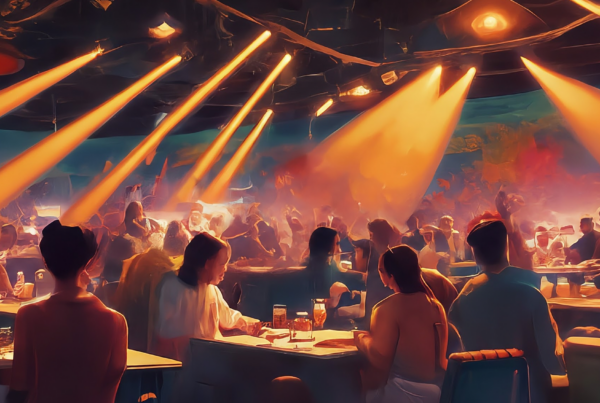In today’s fast-paced world, businesses in the hospitality and entertainment industries are constantly seeking innovative ways to enhance customer experiences and streamline operations. For multi-location organizations, the challenge of maintaining consistent, high-quality entertainment across various sites can be daunting. Enter Centralized Entertainment Strategies—a game-changer for businesses like casinos, restaurants, and bars looking to unify their entertainment offerings while boosting operational efficiency.
Imagine a bustling casino where every screen, from the gaming floor to the bar area, delivers a seamless, captivating experience. Or a restaurant chain where each location offers the same engaging atmosphere, enticing patrons to linger longer and return more often. These scenarios are not just wishful thinking; they are achievable realities with the right centralized strategy in place. According to a report by Statista, businesses that implement such strategies witness a significant increase in customer satisfaction and retention rates.
At DLM Media, we understand the intricate needs of multi-location businesses. Our expertise in commercial video programming solutions positions us as a leader in delivering tailored entertainment experiences that resonate with diverse audiences. Our commitment to high-quality content and reliable service ensures that your patrons enjoy uninterrupted entertainment, enhancing their overall experience.
Throughout this blog post, we will explore effective strategies for implementing centralized entertainment solutions, focusing on how they can transform your business operations. From choosing the right programming provider to leveraging digital signage solutions, we will guide you through the essential steps to elevate your customer experience. Stay with us as we delve into the world of centralized entertainment and discover how DLM Media can help your organization thrive.
Understanding Centralized Entertainment for Multi-Location Businesses
In the dynamic landscape of the entertainment and hospitality industries, maintaining a consistent and engaging customer experience across multiple locations presents a significant challenge. Centralized entertainment solutions offer a powerful strategy to address this challenge by unifying entertainment management across various sites. These solutions not only ensure a consistent customer experience but also streamline operations, making them indispensable for businesses like casinos, restaurants, and bars.
By implementing centralized entertainment strategies, businesses can achieve uniformity in their offerings, enhancing brand loyalty and customer satisfaction. This section delves into the benefits of such an approach, drawing insights from industry leaders like Copper & Vine Studio, who emphasize the importance of standardizing operations while empowering local teams.
Benefits of Centralized Entertainment Solutions
Centralized entertainment solutions provide numerous advantages for multi-location businesses. One of the primary benefits is the ability to deliver a consistent customer experience across all locations. This consistency helps build brand recognition and trust, as customers know what to expect regardless of which location they visit.
Moreover, centralized systems streamline operations by reducing the complexity of managing entertainment across multiple sites. This can lead to cost savings and increased efficiency, allowing businesses to allocate resources more effectively. According to Copper & Vine Studio, standardizing operations through centralized solutions can empower local teams by providing them with the tools and guidelines needed to maintain brand consistency.
Challenges and Solutions for Maintaining Brand Consistency
While centralized entertainment strategies offer significant benefits, they also come with challenges, particularly in maintaining brand consistency. One common challenge is ensuring that all locations adhere to the same standards without stifling local creativity and adaptation.
To address this, businesses can implement standard operating procedures (SOPs) and centralized training programs. These measures ensure that all team members are aligned with the brand’s values and operational standards. Additionally, regular audits and assessments can help identify areas for improvement and ensure compliance across locations.
Case Studies: Successful Implementation of Centralized Entertainment
Several businesses have successfully implemented centralized entertainment solutions, showcasing the potential of these strategies. For instance, a well-known restaurant chain standardized its entertainment offerings across all locations, resulting in a 20% increase in customer retention rates. By utilizing a centralized system, they were able to provide a uniform experience that resonated with customers.
Another example is a casino that integrated a centralized video programming solution, enhancing its customer experience and operational efficiency. This approach allowed them to manage content seamlessly across various screens, ensuring that patrons enjoyed a cohesive and engaging atmosphere.
These case studies highlight the transformative impact of centralized entertainment strategies, demonstrating their ability to enhance customer experiences while streamlining operations. For more insights and strategies, explore our other articles on DLM Media’s website.
Implementing Centralized Entertainment Strategies
Implementing centralized entertainment strategies for multi-location organizations can significantly enhance customer experiences and streamline operations. This section provides a comprehensive guide to help businesses seamlessly integrate these strategies into their operations, focusing on planning, technology integration, and training. Drawing inspiration from industry leaders like Copper & Vine, we emphasize the importance of technology and training programs in achieving successful implementation.
To begin, it is crucial to develop a clear plan that outlines the goals and objectives of your centralized entertainment strategy. This involves identifying the specific needs of each location and determining how a centralized approach can address these needs. By doing so, businesses can ensure that their entertainment offerings are both consistent and tailored to local preferences.
Step-by-Step Guide to Planning
Planning is the cornerstone of any successful strategy. Start by conducting a thorough assessment of your current entertainment systems and identifying areas for improvement. This involves gathering feedback from both customers and staff to understand their experiences and expectations.
Next, establish clear objectives for your centralized entertainment strategy. These objectives should align with your overall business goals and focus on enhancing customer experience, improving operational efficiency, and maintaining brand consistency across locations. Once objectives are set, develop a detailed implementation plan that includes timelines, resource allocation, and key performance indicators (KPIs) to measure success.
Integrating Technology
Technology plays a pivotal role in the successful implementation of centralized entertainment strategies. Invest in robust digital solutions that facilitate seamless content management and distribution across all locations. This includes centralized content management systems (CMS) that allow for real-time updates and customization based on local needs.
Additionally, consider implementing advanced analytics tools to gain insights into customer preferences and behaviors. These tools can help tailor entertainment offerings to better meet customer expectations, ultimately enhancing satisfaction and loyalty. Copper & Vine highlights the importance of leveraging technology to streamline operations and improve decision-making processes.
Training and Development
Training is essential to ensure that all team members are equipped to effectively manage and deliver centralized entertainment solutions. Develop comprehensive training programs that cover both technical and customer service aspects of the strategy. This ensures that staff are knowledgeable about the technology being used and can provide exceptional customer experiences.
Regular training sessions and workshops can help keep staff updated on the latest industry trends and best practices. Encourage feedback from team members to continuously improve training programs and address any challenges they may face. By prioritizing training and development, businesses can empower their teams to deliver consistent and high-quality entertainment experiences across all locations.
Implementing centralized entertainment strategies requires careful planning, technology integration, and ongoing training. By following these steps, businesses can create a cohesive and engaging entertainment experience that resonates with customers and supports operational efficiency. For more insights on enhancing your customer experience through centralized entertainment, explore our resources on DLM Media’s website.
Maximizing Customer Experience with Centralized Entertainment
In the competitive landscape of the hospitality and entertainment industries, enhancing the customer experience is paramount. For multi-location organizations, centralized entertainment strategies offer a unique opportunity to deliver personalized and engaging experiences consistently across all sites. By leveraging centralized systems, businesses can not only streamline their operations but also foster deeper connections with their customers, ultimately boosting loyalty and satisfaction.
Centralized entertainment solutions enable businesses to tailor experiences to individual preferences, creating a sense of community and belonging. This personalization is key to maximizing customer engagement and ensuring that patrons feel valued and understood. Let’s explore how centralized entertainment can transform customer experiences and drive success for multi-location organizations.
Personalized Entertainment Experiences
Personalization is at the heart of creating memorable customer experiences. By utilizing data-driven insights, businesses can customize entertainment offerings to match the preferences and interests of their patrons. For example, a restaurant chain can use centralized systems to analyze customer data and curate playlists or video content that resonates with their audience. This level of personalization not only enhances the dining experience but also encourages repeat visits.
According to a study by Accenture, 91% of consumers are more likely to shop with brands that provide personalized offers and recommendations. This statistic underscores the importance of tailoring entertainment experiences to individual preferences. By implementing centralized entertainment strategies, businesses can deliver personalized content seamlessly across all locations, strengthening customer loyalty and satisfaction.
Community Engagement through Centralized Entertainment
Centralized entertainment solutions also play a crucial role in fostering community engagement. By offering consistent and relevant content, businesses can create a sense of community among their patrons. For instance, a bar chain can host synchronized events across multiple locations, such as trivia nights or live sports screenings, to bring people together and enhance the social experience.
Community engagement initiatives not only attract new customers but also encourage existing ones to become brand advocates. By leveraging centralized entertainment systems, businesses can easily organize and promote events that resonate with their local communities, strengthening their brand presence and customer relationships.
Impact on Customer Loyalty
Investing in centralized entertainment strategies can significantly impact customer loyalty. When customers consistently receive personalized and engaging experiences, they are more likely to develop a strong emotional connection with the brand. This connection translates into increased loyalty and advocacy, as satisfied customers are more inclined to recommend the business to others.
Consider the success story of a casino that implemented a centralized entertainment system to offer tailored gaming experiences. By analyzing player preferences and behaviors, the casino was able to customize game offerings and promotions, resulting in a 30% increase in customer retention rates. This example illustrates the powerful impact that centralized entertainment can have on customer loyalty and business success.
By focusing on personalization and community engagement, multi-location organizations can maximize the benefits of centralized entertainment strategies. These approaches not only enhance the customer experience but also drive long-term loyalty and growth. For more insights on implementing successful entertainment solutions, explore our resources on DLM Media’s website.
Elevate Your Multi-Location Business with Centralized Entertainment
Centralized entertainment strategies for multi-location organizations are more than just a buzzword—they are a transformative approach that can redefine the way businesses operate and engage with their customers. By implementing these strategies, companies can offer a unified experience across all locations, enhancing both customer satisfaction and operational efficiency. This approach is particularly beneficial for businesses in the hospitality and entertainment industries, such as casinos, restaurants, and bars, where consistency and quality are paramount.
One of the primary benefits of centralized entertainment solutions is the ability to deliver a consistent customer experience. Customers appreciate knowing that they will receive the same high-quality service and entertainment, no matter which location they visit. This consistency builds brand loyalty and trust, as patrons feel confident in their expectations being met. Additionally, centralized systems simplify operations by reducing the complexity involved in managing multiple sites, leading to significant cost savings and increased efficiency.
However, implementing these strategies is not without its challenges. Maintaining brand consistency while allowing for local adaptation requires a delicate balance. Businesses can overcome these obstacles by establishing standard operating procedures (SOPs) and comprehensive training programs that align all team members with the brand’s values and standards. Regular audits and assessments ensure adherence to these guidelines, helping to maintain a cohesive brand image across locations.
- **Key Takeaways:**
- Centralized entertainment ensures consistency and enhances customer loyalty.
- Streamlined operations lead to cost savings and efficiency gains.
- Standard operating procedures and training programs support brand consistency.
As you consider implementing centralized entertainment strategies, remember that the right partner can make all the difference. At DLM Media, we specialize in delivering tailored entertainment experiences that resonate with diverse audiences. We invite you to explore our services and discover how we can help your multi-location business thrive. Visit our website at DLM Media for more insights and resources. Let’s elevate your customer experience together!





